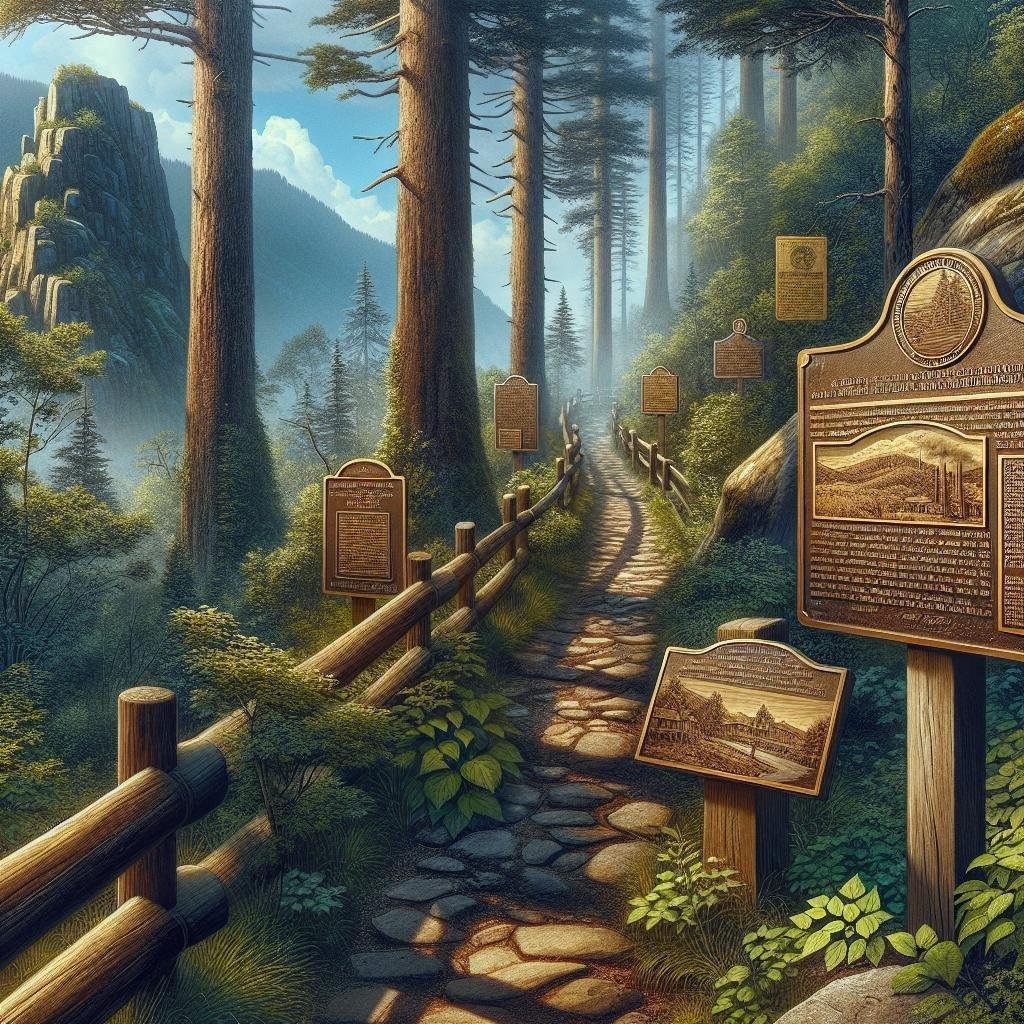Nestled at the gateway to the Great Smoky Mountains,Gatlinburg is not just a haven for outdoor enthusiasts,but also a treasure trove for history buffs. Beyond its bustling streets and charming shops lies a network of hiking trails that weave through a tapestry of the past, inviting visitors to step back in time. These paths, steeped in stories of the settlers, the Cherokee, and the region’s dynamic evolution, offer an immersive experience where each step is a lesson in local heritage. Join us as we lace up our hiking boots and embark on a journey through these trails, where the rustling leaves echo tales of yesteryears and the mountain air is tinged with whispers of history waiting to be discovered.Whether you are a seasoned hiker or a curious explorer, Gatlinburg’s trails offer a uniquely enriching adventure for anyone eager to learn about the roots that hold this charming town together.
Discover Hidden Stories Along the Gatlinburg Trail
Winding through the rustic beauty of the Smoky Mountains, the Gatlinburg Trail offers more than just scenic vistas. As you traverse this 1.9-mile path, you’ll find subtle clues that whisper tales of times gone by. From remnants of old homesteads, where families once carved out a living amidst the wilderness, to intriguing storyboards that stand vigil along the trail, this route serves as a living museum of natural and cultural history.Look for stone chimneys and other forgotten structures that hint at the resilience and ingenuity of the early settlers. Walking through this environment, you gain a profound appreciation for the challenges and triumphs of those who once called this rugged land their home.
As you continue your journey, take a moment to appreciate the rich tapestry of flora and fauna that adds context to the lives of those early pioneers. Amidst towering oaks and whispering pines, you’ll discover plants that were once gathered for medicine, food, and construction, highlighting a lasting way of life that relies on understanding one’s environment.To deepen your connection, consider these fascinating features:
- Historical Markers: Uncover stories of local legends and historical events that have shaped the region.
- wildlife Viewing: Spot native animals that have coexisted with humans for centuries.
- River Insights: Learn about the Little river’s role in supporting the communities that thrived and struggled along its banks.
| Historical feature | Description |
|---|---|
| old Homestead | Remnants that speak of isolation and community life in the mountains. |
| Storyboards | Informative panels offering insights into the trail’s unique history. |
| flora Key | Guide to plants was crucial to early settlers’ survival and well-being. |

Unearth Cultural Gems on the Old Sugarlands Trail
Nestled in the verdant heart of the Great smoky Mountains, the Old sugarlands trail offers more than just a scenic hike; it invites explorers to step back in time. As you traverse its winding path, remnants of bygone eras whisper stories of the industrious communities that once called these forests home. Along the trail, keen-eyed hikers can discover the historic chimneys and stone walls, echoes of the days when the land thrived with the bustling activities of sugarcane farms. Be on the lookout for interpretive markers that share rich narratives about the lives and routines of those early settlers,crafting an educational experience that extends beyond mere observation.
Embarking on this trail is akin to walking through a living museum. With each footstep, the Appalachian history unfolds, revealing layers of resilient human spirit and adaptation to this wild landscape. Must-see features along your journey include:
- Old farmstead ruins: Engage with the fragments of daily life from another century.
- Historic stream crossings: Learn how these waterways powered early industry.
- Flora and fauna: Reflect on the same natural beauty that amazed past generations.
| Feature | Description |
|---|---|
| Chimneys | Remnants of the original homesteads. |
| Stone Walls | Structured boundaries hinting colonial era farm plots. |
| Stream Crossings | Engineered features for trade and transport. |

Step Back in Time with the Alum Cave Bluffs Hike
Experience a journey to the past as you explore one of Gatlinburg’s most intriguing trails. Alum Cave Bluffs offers more than just breathtaking views; it holds a rich tapestry of historical significance. Originally used as a source for mining *Epsom salt* during the Civil War, this trail provides a tangible link to the past. As you hike,you’ll come across fascinating landmarks such as arch Rock and Inspiration Point,each with its own story. These natural wonders served as waypoints for Cherokee tribes long before they became tourist attractions. The dynamism of history and nature converges here, making it an engaging excursion for those keen on understanding local heritage.
Along the path, keep an eye out for these historical and natural highlights:
- Arch Rock: A natural archway sculpted by time, a testament to the geological processes that shaped this region.
- Inspiration Point: Offers panoramic views that have inspired countless visitors,providing a glimpse of what early settlers might have gazed upon.
- Gracie’s Pulpit: Named after a 19th-century local guide, this spot remains a favourite for rest and reflection.
For those interested, here’s a brief overview of Alum Cave’s historical significance:
| Time Period | Significance |
|---|---|
| Pre-1800s | Used by Cherokee tribes |
| 1860s | Mining location during the Civil War |
| 1930s | Developed as part of Great Smoky Mountains NP |
Whether you are following the footsteps of miners, explorers, or simply embracing the scenic beauty, the Alum Cave Bluffs trail offers a unique chance to step back through layers of time, enriching your hike with stories etched in every rock and root along the way.

Explore Historic Wonders on the Little River Trail
If you’re fascinated by the echoes of history etched into the trails of Gatlinburg, the Little River trail is a path well worth exploring. as you meander along this enchanting route,you’ll discover myriad opportunities to step back in time. Highlighted by its scenic beauty, this trail subtly weaves through remnants of long-ago settler cabins, abandoned logging operations, and whispers of early 20th-century life. Highlights of the trail include:
- An old stone chimney, standing like a sentinel of forgotten homesteads.
- Remnants of logging railroads that hint at the area’s industrious past.
- Wildflowers that blanket the landscape in a riot of colors, reminiscent of the natural beauty that once cloaked the region.
to enrich your journey on the Little River Trail, consider these local tips to catch a glimpse of its historical essence. Try visiting during the early morning hours when the fog curls through the trees, creating an eerie, otherworldly atmosphere, perfect for imagining those early settlers’ lives. Additionally, a quick stop by the Elkmont Historic District, a short detour from the trail itself, is well worth your time. This district offers a deeper insight into the community that once flourished in the area, with preserved structures that tell tales of the past.
| Spot | Historical Highlight |
|---|---|
| Old Chimney | Mark of Early Settlers |
| Logging Railroad | Hints of Industrial Past |
| Elkmont District | Preserved Historic Structures |
Q&A
Q&A: exploring the Rich History of Gatlinburg through its Hiking Trails
Q1: What makes Gatlinburg a unique destination for history enthusiasts who also love hiking?
A1: Gatlinburg is nestled in the Great Smoky Mountains, a region brimming with both natural beauty and historical significance. The trails around Gatlinburg allow hikers to explore the remnants of early Appalachian life, homesteads of settlers, and ancient pathways that have been traversed for centuries. This fusion of history and nature makes it a distinctive destination for those eager to learn about local heritage while indulging in outdoor adventures.
Q2: Can you recommend any specific trails that are particularly rich in historical significance?
A2: Certainly! One of the standout trails is the Old sugarlands Trail, which winds through what used to be the Sugarlands community before it became part of the national park. Hikers can discover ruins of old homesteads and a bygone era’s farming equipment. Another notable trail is the Little Greenbrier Trail, which leads to the Little greenbrier Schoolhouse, offering insights into the 19th-century education system and community life.
Q3: How accessible are these trails to beginner hikers interested in history?
A3: Many of the historically significant trails around Gatlinburg cater to hikers of all levels. The Old Sugarlands Trail, for example, is relatively flat and manageable for beginners, making it an excellent choice for those new to hiking. The Little Greenbrier Trail is slightly more challenging but still accessible to novices with a moderate level of fitness. Both offer rewards in terms of historical exploration without overly taxing terrain.
Q4: Are there any guided tours available for those who wont a more in-depth historical experience while hiking?
A4: Yes, there are guided tours available for hikers who wish to delve deeper into the historical contexts of these trails. Local guides offer expertise in the history of the area and can provide narratives and anecdotes that might be missed when hiking solo. these tours frequently enough include visits to hidden gems and lesser-known sites that enrich the historical tapestry of the region.
Q5: What should hikers keep in mind when exploring these trails to ensure a respectful and informative experience?
A5: Hikers should always adhere to the Leave No Trace principles to preserve the integrity of both the natural environment and historical sites. it’s vital to stay on designated trails to protect plant life and reduce erosion. Additionally, respecting historical remnants by not touching or disturbing them is crucial. Lastly,hikers are encouraged to do a bit of research or consult a guidebook beforehand to enrich their understanding and appreciation of the history intertwined within these trails.
Q6: Why is learning about local history while hiking a valuable experience for visitors?
A6: Learning about local history while hiking provides a multidimensional experience, combining physical activity with intellectual curiosity. It allows visitors to literally walk through history, connecting more deeply with the stories and struggles of past inhabitants. This immersive approach enhances not only the appreciation of the landscape but also the cultural heritage of Gatlinburg,fostering a greater sense of connection and understanding.
The Way Forward
As we lace up our boots and tighten our backpacks, the trails of Gatlinburg beckon us not only with the promise of natural beauty but also with whispers from the past. Each path we explore is a gateway to stories long woven into the landscape,a tapestry of tales where nature and history intertwine seamlessly. Whether you’re wandering beneath the shadow of towering trees or standing on the quiet banks of historic streams, these trails are an open-air classroom, extending an invitation to learn, reflect, and connect.
These pathways offer more than just a hike; they grant an opportunity to walk alongside the ghosts of settlers, dreamers, and pioneers, imbuing every step with a profound sense of connection to those who shaped this region. The stories embedded in the winding trails of Gatlinburg enrich our journey, urging us to ponder the enduring impact of our own footsteps on the pages of history. So, as you embark on your next adventure through these remarkable trails, may you carry with you the stories of the past and leave behind footsteps for future wanderers to discover. Happy trails, fellow traveler.

